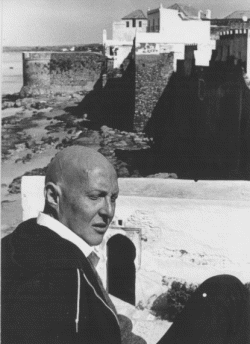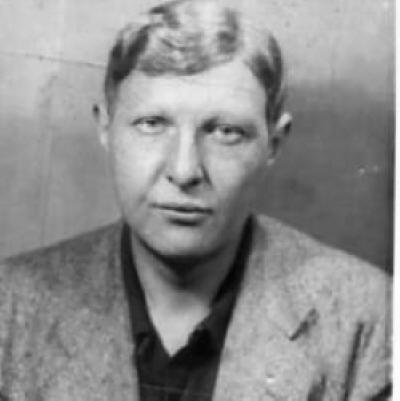

Partner Dris El Kasri
Queer Places:
337 Avenue O, Brooklyn, NY 11230
New York University, 70 Washington Square S, New York, NY 10012
Columbia University (Ivy League), 116th St and Broadway, New York, NY 10027
Asilah 90050, Morocco
MacDowell Colony, 100 High St, Peterborough, NH 03458
 Alfred
Irving Chester (September 7, 1928 – August 1, 1971) was an American writer known for his provocative, experimental work, including the novels Jamie Is My Heart's Desire and The Exquisite Corpse and the short story collection Behold Goliath.
Alfred
Irving Chester (September 7, 1928 – August 1, 1971) was an American writer known for his provocative, experimental work, including the novels Jamie Is My Heart's Desire and The Exquisite Corpse and the short story collection Behold Goliath.
Alfred Irving Chester was born in Flatbush in Brooklyn, New York. X-rays used to treat childhood illness left him bald, and he wore a wig, which though noticeable was not something that people felt comfortable mentioning. He was educated at Orthodox Jewish yeshiva. He attended New York University where he met fellow writers Cynthia Ozick (who later wrote about him in her book Fame & Folly), Sol Yurick and Edward Field (who wrote "The Man Who Would Marry Susan Sontag" which has many chapters dedicated to the biography and literary career of Alfred Chester).
Chester attended graduate school at Columbia University but dropped out. He lived in France for most of the 1950s as an openly gay man.[1] In 1952 his essay "Silence in Heaven" was published in Marguerite Caetani's literary review Botteghe oscure.[2] (Caetani was the U.S.-born wife of an Italian nobleman.)[3] Chester wrote a pornographic novel, Chariot of Flesh, for Olympia Press, using the pseudonym Malcolm Nesbit.[2] His first collection of short stories, Here Be Dragons, was published in 1955. His novel Jamie Is My Heart's Desire was initially published in a French translation, then in an English edition by the British publisher André Deutsch, and only later appeared in the United States. With Caetani's support, he received a Guggenheim Fellowship in 1957.[4] His short story "As I Was Going Up the Stair" was included in Best American Short Stories.[5] Starting in 1959, his short fiction was published in magazines such as The New Yorker, Esquire, and Transatlantic Review. His literary criticism appeared in the New York Review of Books, Partisan Review, and Commentary.[5] He returned to the United States and met Susan Sontag through Harriet Sohmers and María Irene Fornés.[2]

Chester moved to Morocco in 1963. His short story collection Behold Goliath was published in 1964, and his novel The Exquisite Corpse was published in 1967. He associated with Paul Bowles and Jane Bowles while in Morocco, but eventually fell out with both of them.[2]
While visiting New York, Paul Bowles had invited the writer Alfred Chester to join him in Morocco. Chester apparently ‘inspired passionate devotion among friends like Susan Sontag and the poet Edward Field’. Chester met up with Field and his lover, the novelist Neil Derrick, in Gibraltar and crossed to Tangier with them. Finely attuned to the needs of his guests, Paul Bowles immediately introduced him to a nineteen-year-old fisherman called Dris El Kasri, whom he had lined up for the occasion. A few days later, Field and Derrick returned to Paris, whence they had come, but Chester stayed on. By mid-July, he was being fought over by Dris and a boy called Hamji. (‘I feel like Carmen,’ he said.) He had rented a small house near the Bowles’ in Asilah, but before long he developed a rather demonstrative hatred of Paul. As Millicent Dillon describes it, ‘Chester became obsessed with Paul, revering him one moment as a godlike figure and the next moment believing that Paul was poisoning him.’ When Dris moved in with him, Chester was surprised to find that he was in love with the boy. For his own part, Dris proudly declared that he and Chester were ‘the two craziest people in the whole of Morocco’. Asked by a visitor, many years later, ‘Of all the guys who came here, who was the craziest?’ Paul Bowles unhesitatingly nominated Alfred Chester. Back in the city in the spring of 1964, Chester wrote an essay on Jean Genet for Commentary and began writing a new novel, The Exquisite Corpse, dedicated to Dris.
Increasingly, his behavior was made erratic by a combination of mental illness and drug use. It is uncertain if he was ever formally diagnosed, but based on his symptoms, he is believed to have suffered from paranoid schizophrenia, the first symptoms of which he displayed in 1958 at age 30 at the MacDowell Artists Colony in New Hampshire. He died in Israel in 1971.[6] His later writing was published posthumously in collections such as Looking for Genet.[5]
My published books: